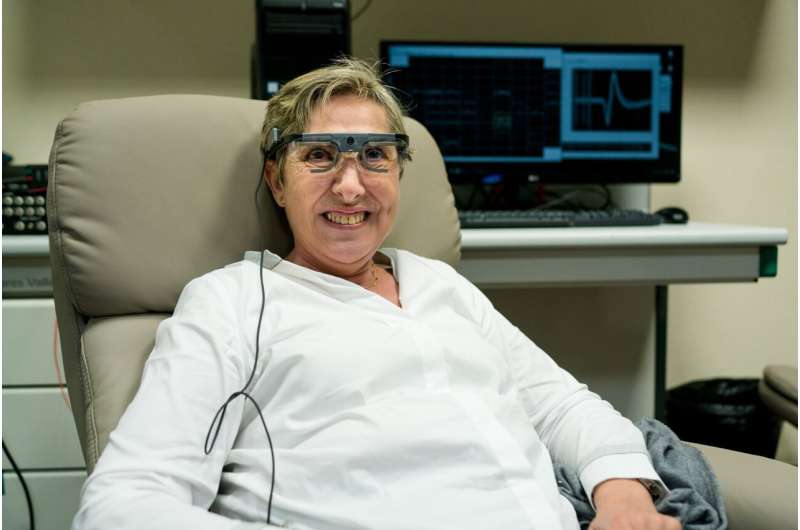Brain implant stimulates the vision of a blind person, allowing her to see simple shapes and letters


A new brain implant based on intracortical microelectrodes can allow a blind person to see shapes and letters. New research by the Miguel Hernández Univresity (UMH) of Spain shows that the implantation of this micro device in the human brain can be done safely, and that the direct stimulation of the cerebral cortex produces visual perceptions with a much higher resolution than had been achieved until now. The Biomedical Engineering group of the UMH, led by Cellular Biology Professor Eduardo Fernández Jover, has published the results of the experiment in the Journal of Clinical Investigation.
In December 2020, this same team of researchers carried out a similar experiment by stimulating the visual cortex of primates. An implant with over 1,000 electrodes was used in that case, allowing the animals to see shapes, movement and letters. However, the animals were not blind.
“This study goes a little further. We have implanted [the micro electrodes] in the brain of a person who has been completely blind for over 16 years,” says Jover, who is also a member of the Centre for Biomedical Research Network in Bioengineering, Biomaterials and Nanomedicine. The volunteer, a 57-year-old woman, has been able to identify letters and even the silhouette of some objects.
This is the first time that a brain implant of this type has been performed in a blind person, and professor Eduardo Fernández explains that the results are encouraging for the development of a visual neuroprosthesis that can help blind people or those with low or residual vision to improve their mobility, and even in a more ambitious way, to perceive their surroundings and orient themselves. However, the UMH researcher adds that, although the results of this and other studies are promising, there are still many issues to solve, which is why steps must be taken gradually and false expectations must not be created. For now, it is an ongoing investigation.
https://youtube.com/watch?v=HQyk1d92Oc8%3Fcolor%3Dwhite
For six months, the researchers performed experiments in which the volunteer had to try to identify letters, their position and the shape of different objects. These took place several times to observe the learning process of the person’s visual cortex and to see possible changes.
The implanted device is a small, three-dimensional matrix with 100 micro electrodes that communicates with the brain cells in a bidirectional way: It registers electric signals and stimulates the brain. It is 4 millimeters wide, with electrodes that are 1.5 mm long. One of the conclusions of the study is that this does not impact the function of the brain cortex or of the neurons next to the implant.
The UMH researcher explains that the results of this new study show that implanting and explanting this type of micro-device can be performed safely for humans, and that the electric stimulation of these electrodes, which penetrate the cerebral cortex, can safely induce visual perceptions with much higher resolutions than those achieved previously. Fernández Jover says, “The amount of electric current needed to induce visual perceptions with this type of microelectrode is much lower than the amount needed with electrodes placed on the surface of the brain, which means greater safety.”
https://youtube.com/watch?v=pPqluZ5z7xM%3Fcolor%3Dwhite
The full stimulation system includes an artificial retina which emulates the operation of the human visual system, which is placed in regular glasses. The artificial retina captures the visual field in front of the person and transforms it into streams of electrical impulses that are optimized to stimulate the neurons of the visual cortex via the small micro electrodes. “Thanks to this, the implanted person was able to recognize several complex stimulation patterns and accurately perceive shapes and letters,” explains the UMH professor. Furthermore, there is a learning process over time, meaning that with the appropriate training, it becomes easier to recognize different patterns. To help her with the learning process, the researchers created several videogames, such as a variation of the classic Pac-Man, and a game based on the popular television series “The Simpsons.”
In the context of this research, professor Fernández Jover says that developing visual neuroprosthesis is a necessity for the future, as there are no useful treatments or aid devices for many blind people. For example, patients with advanced degenerative diseases of the retina, severe glaucoma or pathologies that harm optical nerves, cannot benefit from the modern retina prostheses that are being developed in some centers. In these cases, information from the surroundings must be sent straight to the part of the brain that processes vision, and the results of this study, while preliminary, indicate that this is possible, and that even after many years of total blindness, the human brain can still process visual information.
Source: Read Full Article